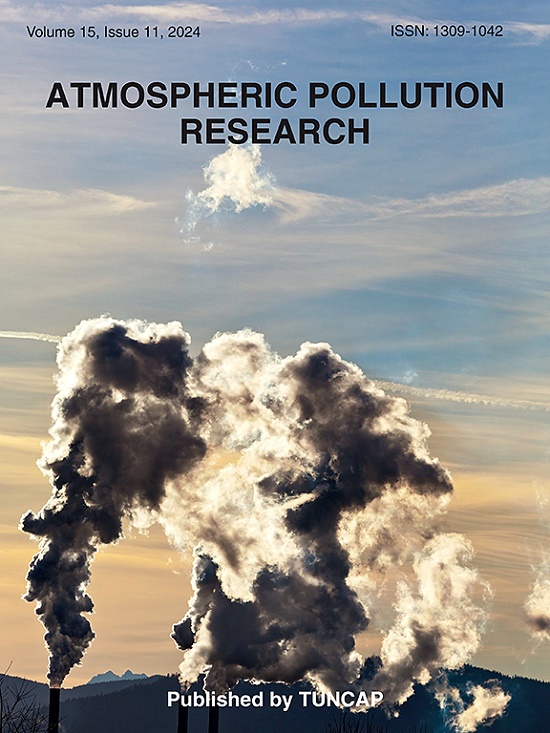基于WRF-CMAQ和ISAM的长三角PM2.5源分配综合建模框架
IF 3.5
3区 环境科学与生态学
Q2 ENVIRONMENTAL SCIENCES
引用次数: 0
摘要
随着PM2.5污染问题的日益复杂和排放源的多样性,源解析分析已成为更好地了解PM2.5污染本质的重要工具。采用天气研究与预报(WRF)模型和社区多尺度空气质量(CMAQ)模型两层嵌套,结合ISAM污染源分析模块,对长三角城市群PM2.5排放源进行了分析。综合分析秋冬两季PM2.5行业源数据,发现南京秋季以工业源为主,杭州秋季以居民源为主,合肥秋季污染成分较为复杂,上海秋季交通源贡献明显下降。从季节上看,冬季PM2.5浓度总体高于秋季。农业、工业和发电来源的贡献增加尤其突出,表明冬季排放强度增大或大气扩散条件变差。通过对两个季节长三角城市群交通运输路径的跟踪研究发现:冬季,区域内交通运输、区域外交通运输对长三角城市群交通运输的贡献率分别为15.05% ~ 36.3%、35.60% ~ 62.10%和16.9% ~ 36.23%;秋季的贡献率分别为26.00% ~ 45.13%、31.51% ~ 56.44%和17.56% ~ 27.59%。总体而言,与秋季相比,冬季局地源对PM2.5的贡献减小,而远程输送对PM2.5的贡献增加。本文章由计算机程序翻译,如有差异,请以英文原文为准。
An integrated modeling framework for PM2.5 source apportionment in the Yangtze River Delta using WRF-CMAQ and ISAM
With the increasing complexity of the PM2.5 pollution problem and the diversity of emission sources, source apportionment analysis has become an important tool to better understand the nature of PM2.5 pollution. In this study, the PM2.5 emission sources in the Yangtze River Delta (YRD) urban agglomeration were analyzed using a two-layer nested the Weather Research and Forecasting (WRF) model and the Community Multiscale Air Quality (CMAQ) model, combined with the Integrated Source Apportionment Method (ISAM) pollution source analysis module. Based on a comprehensive analysis of sectoral PM2.5 source data for the autumn and winter seasons, key characteristics emerged: Nanjing was dominated by industrial sources, Hangzhou was prominent in residential sources, Hefei had a relatively complex pollution composition, and Shanghai saw a significant decrease in contributions from transportation sources in autumn. From a seasonal perspective, the overall PM2.5 concentration was higher in winter than in autumn. This was particularly marked by increased contributions from agricultural, industrial, and power generation sources, indicating either greater emission intensity or poorer atmospheric dispersion conditions during winter. By tracking the transport pathways across the Yangtze River Delta (YRD) urban agglomeration in both seasons, we found the following: In winter, the contribution percentages from local sources, intra-regional transport, and extra-regional transport were 15.05 %–36.3 %, 35.60 %–62.10 %, and 16.9 %–36.23 %, respectively. In autumn, the respective contributions were 26.00 %–45.13 %, 31.51 %–56.44 %, and 17.56 %–27.59 %. Overall, compared to autumn, the contribution of local sources to PM2.5 decreased during winter, while the proportion from long-range transport increased.
求助全文
通过发布文献求助,成功后即可免费获取论文全文。
去求助
来源期刊

Atmospheric Pollution Research
ENVIRONMENTAL SCIENCES-
CiteScore
8.30
自引率
6.70%
发文量
256
审稿时长
36 days
期刊介绍:
Atmospheric Pollution Research (APR) is an international journal designed for the publication of articles on air pollution. Papers should present novel experimental results, theory and modeling of air pollution on local, regional, or global scales. Areas covered are research on inorganic, organic, and persistent organic air pollutants, air quality monitoring, air quality management, atmospheric dispersion and transport, air-surface (soil, water, and vegetation) exchange of pollutants, dry and wet deposition, indoor air quality, exposure assessment, health effects, satellite measurements, natural emissions, atmospheric chemistry, greenhouse gases, and effects on climate change.
 求助内容:
求助内容: 应助结果提醒方式:
应助结果提醒方式:


